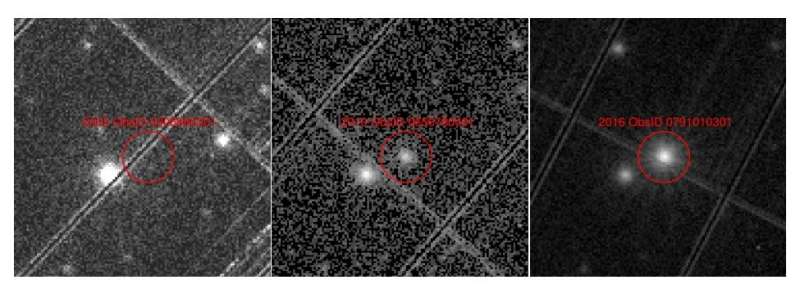November 27, 2018 report
New ultra-luminous X-ray pulsar discovered

Using ESA's XMM-Newton and NASA's NuSTAR space telescopes, a team of astronomers from Germany has detected a new ultra-luminous pulsar in the galaxy NGC 300. The finding of this pulsar, which received designation NGC 300 ULX1, is detailed in a paper published November 9 on the arXiv pre-print repository.
Ultra-luminous X-ray sources (ULXs) are point sources in the sky that are so bright in X-rays that each emits more radiation than 1 million suns emit at all wavelengths. Although they are less luminous than active galactic nuclei, they are more consistently luminous than any known stellar process.
Astronomers generally believe that due to their brightness, most ULXs are black holes. However, recent observations have found that some ULXs showcase coherent pulsations. These sources, known as ultra-luminous X-ray pulsars (ULXPs), are neutron stars typically less massive than black holes. The list of known ULPs is still relatively short, hence detecting new objects of this class is essential for researchers studying the universe in X-rays.
Now, a group of astronomers from Max Planck Institute for extraterrestrial Physics in Garching, Germany, led by Chandreyee Maitra, reports the detection of pulsations from the source NGC 300 ULX1, located in the spiral galaxy NGC 300, some six million light years away from the Earth. Discovered in 2010, NGC 300 ULX1 was initially classified as a supernova, but later re-classified as a possible high mass X-ray binary.
By analyzing data from simultaneous observations of NGC 300 ULX1, performed in December 2016 using X-ray Multi-Mirror Newton (XMM-Newton) and Nuclear Spectroscopic Telescope Array (NuSTAR) spacecraft, Maitra's team identified pulsations from this source.
"Pulsations from NGC 300 ULX1 were discovered during simultaneous XMM-Newton/NuSTAR observations in Dec. 2016," the researchers wrote in the paper.
According to the study, NGC 300 ULX1 had a spin period of about 31.71 seconds at the start of NuSTAR observations, which decreased linearly within a few days to approximately 31.54 seconds at the end of the XMM-Newton/NuSTAR observing campaign. The observations also found that the pulsar has a spin-up rate of 556 ns/s and a broadband unabsorbed luminosity of 4.7 duodecillion erg/s.
Furthermore, the astronomers checked archival data from observations of NGC 300 ULX1 using NASA's Swift space telescope and Neutron star Interior Composition Explorer (NICER) on the International Space Station. These data show that the spin period of this pulsar decreased exponentially from about 45 to 17.5 seconds during a timespan of 2.3 years.
The researchers noted that NGC 300 ULX1 is the fourth ULXP known to date, and exhibits an extreme spin-up rate, as well as a relatively constant luminosity over a long span of time. They added that its spin-up rate is one of the highest ever observed from an accreting neutron star.
In concluding remarks, the authors of the paper underlined that due to its properties, NGC 300 ULX1 could provide a rare opportunity for astronomers to study spin evolution of accreting neutron stars at extreme accretion rates. The pulsar could also help us better understand the similarities between ULXPs and supergiant high mass X-ray binaries.
More information: Chandreyee Maitra et al. NGC 300 ULX1: A new ULX pulsar in NGC 300. arXiv:1811.04807 [astro-ph.HE], arxiv.org/abs/1811.04807
© 2018 Science X Network





















